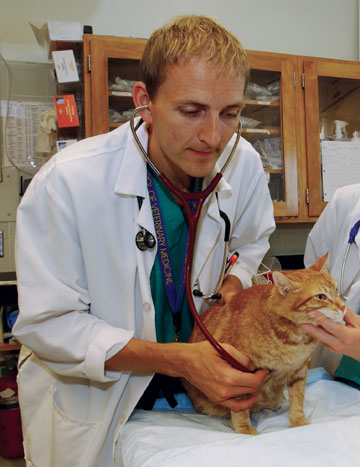Volume 26 · Number 2 · Winter 2009

Male veterinarians like Karl Jandrey, a small animal emergency and critical care specialist at UC Davis, are becoming increasingly outnumbered by female vets. (Photo: Debbie Aldridge/UC Davis)
Male Vets: A Disappearing Breed
Nowhere has the gender shift on campus been as striking as in veterinary medicine, where students in the D.V.M. program and a popular pre-vet undergraduate major are now 80 percent female.
That ratio at the School of Veterinary Medicine is a complete reversal from 35 years ago, when four out of five students were men.
Similarly, the once-male-dominated animal sciences undergraduate major today is more than 80 percent female—the great majority of them aspiring veterinarians, though many end up going into related fields.
Other veterinary schools across the country have seen a similar trend. As a result, women became a majority of small-animal veterinarians in the U.S. in 2007, according to the American Veterinary Medical Association.
Reasons for the increase in women, many veterinarians and students say, include declining discrimination, flexibility in work schedules, a shift in the profession from livestock to family pet care and better drugs and handling techniques that make physical strength less important. The decline in men may reflect salaries, which the veterinary association says were right behind those of doctors in the 1970s but are now about 60 percent of physicians’ average pay. According to the association, veterinarians in private practice made an average annual salary of $105,510 in 2005, compared with $175,000 averaged by physicians.
